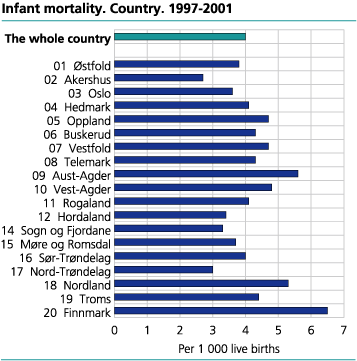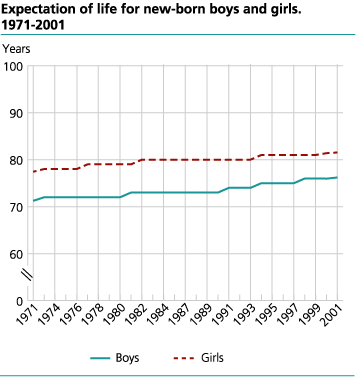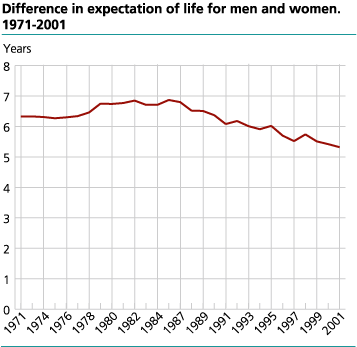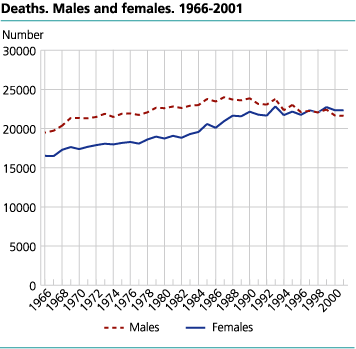Content
Published:
This is an archived release.
Fewer infants die, and we live longer
Infant mortality is still low in Norway: Less than 4 of 1 000 infants die during their first year. Newborn boys can be expected to live 76.2 years and newborn girls can be expected to live 81.5 years. During the last thirty years, men's life expectancy has increased with 5 years and for women with 4 years.
Infant mortality still low
Infant mortality, which is deaths under one year of age per 1000 live births, was 3.9 in 2001. As in the previous two years the infant mortality was at the same low level, just below 4.0. In 1999 and 2000 the infant mortality rate was 3.8 and 3.9 respectively.
The infant mortality rate for girls is lower than the infant mortality for boys. In 2001 it was 4.3 for boys and 3.5 for girls.
Few infants die in the Nordic countries
According to Eurostat , the infant mortality in the Nordic countries is among the lowest in the world. In 1999, Iceland had 2.4, Finland 3.6 and Sweden 3.4 deaths under one year of age per 1000 live births. Only Denmark had higher infant mortality rate than Norway, with 4.2. In the rest of the world, some Asiatic countries, as Japan and Singapore, have very low infant mortality, around 3.5.
The county Akershus had the lowest infant mortality with 2.7, followed by Nord-Trøndelag with 3.0 and Sogn og Fjordane with 3.2.
Less difference in life expectancy between the sexes
Life expectancy in Norway increased by 0.25 years for boys and 0.15 years for girls from 2000 to 2001.
Men have had a better development in lifetime than women. During the last thirty years lifetime for men and women has approached each other by one year. Thirty years ago it was estimated that newborn girls could live 6.3 years longer than boys. In 2001 the difference was 5.3 years. The difference in life expectancy for men and women decrease as one get older. For persons who are 80 years of age, the difference is 1.9 years.
The Swedes have longest life in the Nordic countries
Eurostat figures from 1999 show that among the Nordic countries, Sweden is the only country with a higher life age for women than Norway, with an age of 81.9 years. In the rest of Europe the Mediterranean countries (France, Spain and Italy) have longer lifetime for women with respectively 82.2, 82.0 and 81.6 years.
44 000 deaths last year
In 2001 44 000 persons died, the same number as the year before. There were 22 350 women and 21 650 men who died, about 700 more women than men. This tendency is the same as the last two years, but for all previously years, it has been quite opposite: more men than women die.
54 per cent of those who died last year were 80 years or older. About 60 per cent of the persons who died in the age group 80 years and older, were women.
Tables:
- Table 1 Deaths and death rates. 1961-2001
- Table 2 Death males and females, by age and county. 2001
- Table 3 Deaths, by age and county. Males. 2001
- Table 4 Deaths, by age and county. Females. 2001
- Table 5 Deaths per 1 000 population, by county. Standardized rates. 1949-1985
- Table 6 Age-specific death rates for males and females. 1971-2001
- Table 7 Expectation of life for males and females at selected ages. 1946-2001
- Table 8 Perinatal and infant mortality. 1956-2001
- Table 9 Infant mortality, by county. 1966-2001
- Table 10 Life tables . 2001
- Table 11 Expectation of life for males and females at selected ages, by county. 1971-2000
Contact
-
Anders Sønstebø
E-mail: anders.sonstebo@ssb.no
tel.: (+47) 46 66 37 74
-
Magnus Haug
E-mail: magnus.haug@ssb.no
tel.: (+47) 40 81 14 91
-
Ane Margrete Tømmerås
E-mail: ane.tommeras@ssb.no
tel.: (+47) 91 99 29 62
-
Statistics Norway's Information Centre
E-mail: informasjon@ssb.no
tel.: (+47) 21 09 46 42
-
Oppdrag befolkningsstatistikk
E-mail: befolkning@ssb.no




